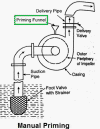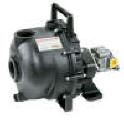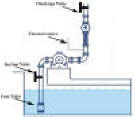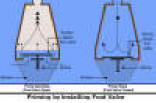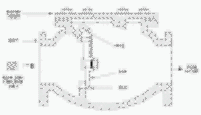| Pump priming |
| |
| Pump Priming is the
process of removing air from the pump and suction line. In this process
the pump is been filled with the liquid being pumped and this liquid
forces all the air, gas, or vapour contained in the passage ways of pump
to escape out. Priming maybe done manually or automatically. Not all
pumps require priming but mostly do. There are Self Priming Pumps and
also some layout situations where priming is not required. |
| |
| Priming a pump
is probably the first and one of the most important thing one
should do before operating it. Not priming a pump or not doing
it properly makes majority of pump problems. Any problem in pump
due to lack of priming may cause financial impact due to pump
maintenance and the downtime of piping system due to a
malfunctioning pump. |
 |
|
| Why Priming is
Required? |
| Priming reduces the risk
of pump damage during start-up as it prevents the the pump impeller to
becomes gas-bound and thus incapable of pumping the desired liquid.
For reliable operation,
pumps must first be primed; that is, air or gases to be expelled from
the suction and impeller eye area and replaced with liquid to be pumped.
The pump would not function properly when not completely filled with
liquid. Along with compromised performance, not priming the pump and
allowed to run without fluid, it will overheat the pump system and there
will be a danger of damage to critical internal pump components. |
| |
| When Priming is Not
Required? |
| Priming is only not
required when the pump is either capable of removing air and gases from
itself (also known as Self Priming Pumps) or the layout conditions are
so much favourable that the pump will be always completely filled with
the liquid to be pumped. Few such conditions are detailed out below. |
- Priming is not
required when pump is submerged (Submersible or Vertical Sump
Pumps).
- Priming is not
required when the pump is at a lower elevation than the supply and
this ensures that pump suction will be completely filled with liquid
at all times (known as “Flooded Suction Condition”).
- Self Priming Pumps.
|
| Methods of Priming
Videos |
| Priming of a pump can be
achieved by either layout consideration, or by means of some external
arrangements that ensures priming or by use of Self Priming Pumps. Few
of the external arrangements that ensures priming of a pump are detailed
out below. |
|
|
|
Manual Priming |
| In this method of pump priming, liquid is poured in the pump
suction. This can be achieved by pouring liquid directly in suction or
with the help of other devices like a funnel and the pump will be
manually primed with a gravity feed. While priming is being done, all
the air escapes through air vent valve. |
|
|
| |
|
Priming by Installing Foot
Valve |
| In this method of pump
priming, a foot valve (functioning as a NRV) is installed in the suction
piping to insure that the liquid will not drain from the pump casing and
suction piping once the pump stops operating. A foot valve is a form of
check valve installed at the bottom, or foot, of a suction line. When
the pump stops and the ports of the foot valve close, the liquid cannot
drain back from pump suction if the valve seats tightly. Keep in mind
that these foot valves have a nasty habit of leaking. |
|
|
| |
| |
| |

